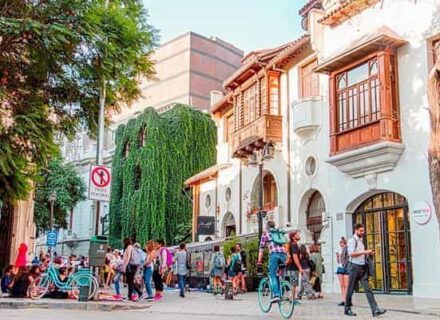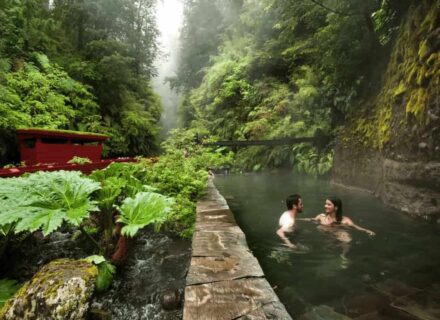Rising majestically above the bustling streets of Santiago, Chile, the Teleférico de Santiago offers visitors an unforgettable aerial adventure through one of South America’s most impressive urban parks. This remarkable cable car system, nestled within the sprawling Metropolitan Park of Santiago, has become the capital city’s premier attraction, providing breathtaking panoramic views of the sprawling metropolis below and the towering Andes Mountains that frame the horizon.
A Gateway to Latin America’s Largest Urban Park
The Santiago Cable Car operates within the Metropolitan Park of Santiago (Parque Metropolitano), a massive green oasis that stands as Chile’s largest urban park and one of the world’s most extensive metropolitan green spaces. Covering an impressive 722 hectares, this natural sanctuary spans across four different communes: Providencia, Vitacura, Recoleta, and Huechuraba, creating a unique administrative collaboration that benefits the entire Santiago metropolitan area.
What makes this park truly exceptional is its accessibility and diversity of attractions. Unlike many urban parks that charge entrance fees, the Metropolitan Park maintains an open-access policy, welcoming visitors from all walks of life to explore its numerous attractions, hiking trails, and recreational facilities. The cable car system serves as both a means of transportation and a tourist attraction, connecting various points of interest throughout the park while offering spectacular aerial views that would otherwise be impossible to achieve.
The Engineering Marvel: Three Stations, Endless Views
The Santiago Cable Car system is an impressive feat of engineering that was conceived and constructed beginning in 1979. The project faced significant challenges due to the rugged volcanic rock terrain of San Cristóbal Hill, requiring innovative construction techniques and careful planning to ensure both safety and functionality. Despite these obstacles, the cable car was successfully completed and has been operating reliably for decades, transporting millions of visitors safely through the skies above Santiago.
The system operates through three strategically positioned stations: Oasis, Tupahue, and Cumbre (Summit). Each station offers unique experiences and serves different purposes within the broader park ecosystem. The journey between these stations provides passengers with constantly changing perspectives of the city, mountains, and park landscape below.
The Oasis station, located at the lower elevation, serves as the primary entry point for many visitors. This station is conveniently positioned near various park amenities and provides easy access to ground-level attractions. From Oasis, visitors can also access the high ropes adventure park, making it a popular destination for families seeking active outdoor experiences.
The Tupahue station, positioned at the middle elevation, offers an intermediate stop that allows visitors to explore different sections of the park. This station provides access to hiking trails, viewpoints, and other recreational facilities, making it an ideal starting point for those who wish to combine their cable car experience with ground-based activities.
The Cumbre station, situated at the summit of San Cristóbal Hill, represents the crown jewel of the cable car experience. At this highest point, visitors are treated to unparalleled 360-degree views of Santiago and the surrounding landscape. The summit station also connects with the Santiago Funicular, a heritage railway system that provides an alternative means of reaching the hilltop while offering its own unique historical and scenic experience.
A Window to Santiago’s Urban Landscape
The cable car journey provides passengers with a unique perspective on Santiago’s urban development and geographical setting. As the cabins glide silently above the park’s terrain, riders can observe the stark contrast between the natural green space of the Metropolitan Park and the dense urban development that characterizes Chile’s capital city. On clear days, the views extend far beyond the city limits, encompassing the snow-capped peaks of the Andes Mountains to the east and the lower coastal ranges to the west.
The aerial perspective also reveals Santiago’s urban planning and architectural diversity. Modern skyscrapers in the financial district stand alongside traditional neighborhoods with red-tiled roofs, creating a visual tapestry that tells the story of the city’s evolution over time. Unfortunately, on some days, the views also include the visible effects of air pollution that occasionally affects the Santiago metropolitan area, serving as a reminder of the environmental challenges facing many large urban centers worldwide.
Comprehensive Visitor Experience
The cable car operates on a schedule designed to accommodate both local residents and international tourists. From Tuesday through Sunday, the system runs from 10:00 AM until 6:45 PM, with the last descent occurring at closing time. Mondays are reserved for maintenance, ensuring that the system remains in optimal condition for safe and reliable operation. This schedule allows for full-day exploration of the park and its various attractions while providing adequate time for maintenance and safety checks.
The operating hours align perfectly with the park’s broader schedule and complement the numerous other attractions available throughout the Metropolitan Park. Visitors can easily combine their cable car experience with visits to the Chilean National Zoo, which houses more than 50 animal species including the adorable Magellanic penguins from southern Chile. The zoo provides an educational component to the park experience, showcasing both native Chilean wildlife and species from around the world.
Natural and Cultural Attractions
Beyond the cable car itself, the Metropolitan Park offers an impressive array of natural and cultural attractions that enhance the overall visitor experience. The Mapulemu Botanical Garden spans nearly 10 acres and features an extensive collection of endemic Chilean flora, including both flowering plants and native tree species. This botanical showcase provides visitors with insight into Chile’s unique plant biodiversity and the importance of conservation efforts in protecting native ecosystems.
The Japanese Garden represents another cultural highlight within the park, offering a tranquil space designed according to traditional Japanese landscape principles. This carefully maintained garden provides a peaceful contrast to the more active attractions within the park and demonstrates the international cultural connections that enrich Santiago’s urban landscape.
The Sanctuary of the Immaculate Conception, located at the summit of San Cristóbal Hill, serves as both a religious site and a cultural landmark. This iconic structure is visible from many points throughout Santiago and has become a symbol of the city. The sanctuary provides a spiritual dimension to the park experience and offers additional panoramic viewing opportunities for visitors who make the journey to the summit.
Recreational Activities and Adventure Sports
The Metropolitan Park caters to visitors with diverse interests and activity preferences. Adventure enthusiasts can experience the high ropes course located near the Oasis station, which provides thrilling challenges suitable for various skill levels. This addition to the park’s offerings demonstrates the commitment to providing active recreational opportunities that appeal to younger visitors and families seeking more adventurous experiences.
For those preferring ground-based activities, the park features an extensive network of hiking and biking trails that wind through different sections of the 722-hectare space. These trails offer various difficulty levels, from gentle walks suitable for all ages to more challenging hikes that reward visitors with spectacular viewpoints and closer encounters with the park’s natural environment.
The park also includes swimming facilities, picnic areas, and designated spaces for outdoor recreation, making it a comprehensive destination for day-long family outings or extended exploration. The variety of available activities ensures that visitors can customize their experience based on their interests, physical abilities, and available time.
Historical Significance and Urban Development
The Metropolitan Park’s creation in April 1966 marked a significant milestone in Santiago’s urban development and environmental planning. The park was established by incorporating the Chilean National Zoo and the services of San Cristóbal Hill, creating a unified management structure that has enabled coordinated development and maintenance of this vast green space.
The park’s management extends beyond the primary 722-hectare site to include 16 urban parks distributed throughout 13 different communes in Santiago, representing a total area of almost 150.1 hectares. This expanded network demonstrates the broader commitment to urban green space development and environmental conservation throughout the Santiago metropolitan region.
The ongoing maintenance and development of these spaces involves comprehensive conservation programs that include cleaning, irrigation, replantation of vegetation, maintenance of urban equipment, sanitation control, weed management, fertilization, and security measures. These activities ensure that the park continues to serve its multiple functions as a recreational destination, environmental preserve, and educational resource for current and future generations.
Practical Information and Access
The Santiago Cable Car system is designed to be accessible and user-friendly for visitors of all ages and backgrounds. The modern cabins provide comfortable seating and large windows that maximize viewing opportunities during the journey between stations. Safety features and regular maintenance ensure that the system meets international standards for aerial transportation systems.
Visitors can purchase tickets at the various stations, and the pricing structure is designed to be affordable for both local residents and international tourists. The cable car system integrates seamlessly with other transportation options within the park, including the historic funicular railway that provides an alternative means of reaching the summit while offering its own unique experience and historical significance.
The park’s location within Santiago makes it easily accessible via public transportation, private vehicles, or organized tours. Clear signage and information materials help visitors navigate the various attractions and make the most of their time within this remarkable urban oasis.
A Must-Experience Santiago Attraction
The Santiago Cable Car and Metropolitan Park combination represents far more than a simple tourist attraction; it embodies the successful integration of urban development, environmental conservation, and recreational opportunity that serves as a model for cities worldwide. The cable car system provides not only spectacular views and convenient transportation but also serves as a gateway to understanding Santiago’s geography, urban development, and commitment to preserving green space within a major metropolitan area.
Whether visitors are seeking adventure, relaxation, cultural enrichment, or simply a different perspective on one of South America’s most important cities, the Santiago Cable Car delivers an experience that combines the thrill of aerial transportation with the beauty of Chile’s natural landscape and the vibrancy of its urban environment. As Santiago continues to grow and evolve, this remarkable attraction stands as a testament to the importance of preserving and enhancing urban green spaces that benefit residents and visitors alike while providing sustainable recreational opportunities for future generations.
The journey aboard the Santiago Cable Car offers more than transportation from point A to point B; it provides a unique opportunity to see, understand, and appreciate the remarkable city of Santiago from an entirely new perspective, making it an essential experience for anyone visiting Chile’s dynamic capital city.



